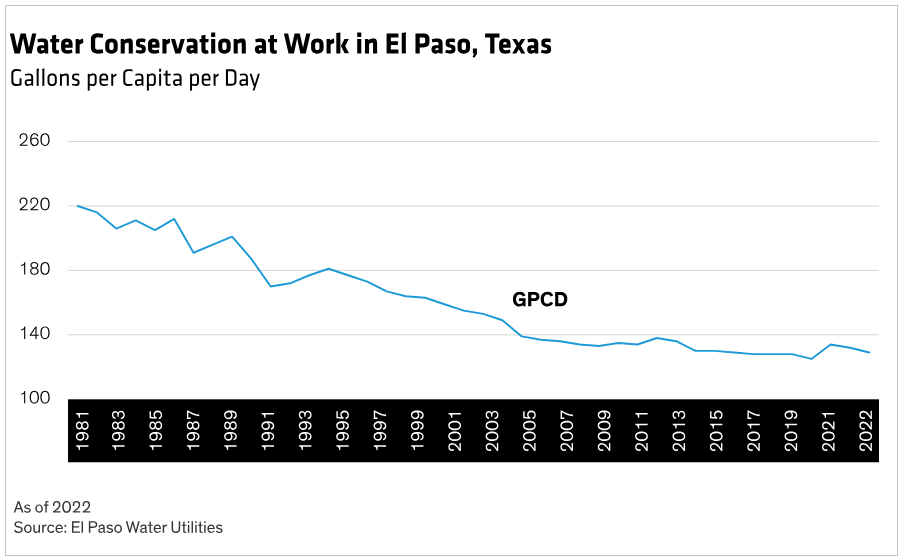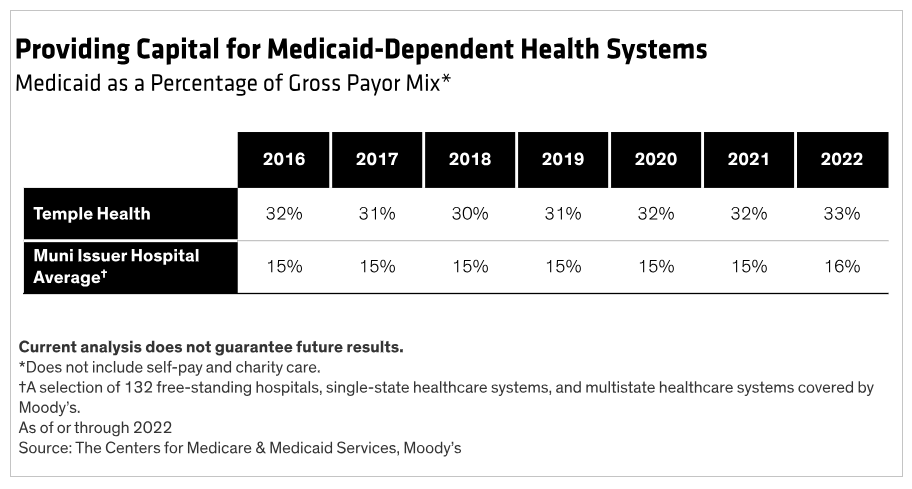Written by: Marc Uy
Municipal bond issuers are responsible for building and supporting the physical infrastructure and the public goods and services that enable citizens to participate more in an inclusive economy. That makes the roughly $4 trillion US municipal bond market fertile ground for impact investing. Challenges like supplying clean water and improving access to quality healthcare can both be tackled through environmentally, socially, and financially productive investments in communities and institutions.
Leading When Water Is Lacking
As we’ve seen over the past few years, access to water can’t be taken for granted. The country faces historic drought conditions in the West and other regions. For instance, the Rio Grande, a river that countless Southwestern US communities depend on, faces persistent drought and increased water demand.
These challenges disproportionately impact low-income communities. In one study, 14% of respondents said a $12 monthly increase in water bills would lead them to cut back spending on groceries and basic medical care.1 Long-term investments in projects that diversify water sources, combined with water conservation strategies, can go a long way toward improving drought resiliency and reducing the financial burden communities face.
Take El Paso Water, which provides water, wastewater, reclaimed water and drainage services to more than 678,000 residents of El Paso, Texas, and surrounding areas. El Paso’s median household income is 76% of the state’s median; its 18% poverty rate is 29% higher than the statewide rate.
Since El Paso adopted its Water Conservation Ordinance in the early 1990s, per capita water consumption has fallen by roughly 35% and peak water demand by 17% (Display). Strategies implemented include reducing water waste in utility operations through initiatives such as leak detection and maintaining a rate structure that encourages conservation. Education is a lynchpin in galvanizing residential and commercial customers to be more efficient.

The issuer understands the population it serves, so its rates are affordable relative to national medians. And a change in the most recent budget waives the water-supply replacement charge for El Paso’s lowest water users. In fiscal year 2018–19, roughly 50% of all goods and services bought by the issuer were sourced from small, minority, and women-owned businesses, and almost 34% of its construction-project spending was directed to those vendors. By understanding the unique needs of the communities they serve and implementing long-term strategies to address them, municipal issuers like El Paso Water create more equitable and sustainable systems. It’s a model that also applies to healthcare institutions.
Opening Access to Care
Consider that for patients, roughly 20% of health outcomes are determined by the quality of healthcare from providers. The other 80% stem from factors often referred to as social determinants of health (SDoH): substandard housing, poor education systems, neighborhood violence, drug addiction, violence, and food insecurity.2
Recognizing this, many healthcare institutions are transitioning their missions from treating disease to also helping prevent it. For example, Temple University Health—a safety-net hospital—was originally founded to care for patients with limited incomes and ensure access to care in its surrounding Philadelphia neighborhoods. Today, it serves a population in which 45% of households are below the federal poverty level3—versus only 7% in adjacent Montgomery County. Roughly 33% of Temple Health’s gross revenues come from Medicaid—that’s more than double the average share among the nonprofit hospitals tracked by Moody’s (Display).

Temple Health’s impact extends well beyond the bedside. Its Center for Population Health, established in 2014, includes patient-centered medical homes, chronic-disease management programs for high-risk populations using nurse navigators, an inpatient and outpatient community-health work program, peer coaching, and central access for scheduling and follow-ups.
To help patients with complex social and medical-health issues, Temple’s Community Health Worker team visits homes, schedules and attends doctor appointments, coordinates transportation, and connects with other social supports to improve quality-of-life and treatment outcomes.
In 2020, Temple launched the Multi-Visit Patient Clinic to provide a full continuum of care for patients with high emergency-department use and frequent inpatient admissions. On discharge, community health workers link patients with follow-up healthcare, provide meals and transportation, visit homes, and connect with other social supports. Clinic patients have reduced emergency department use by 40% and inpatient use by 21% while increasing the use of outpatient services by 50%,4 demonstrating that they’re seeking more appropriate care in effective settings.
Temple Health also collaborated with local nonprofits, launching a two-year program to help 25 homeless Medicaid patients who frequent hospital emergency departments. Patients are provided free housing and caseworkers to connect them with health and social services. Caseworkers assist patients by furnishing apartments, connecting them with healthy meals, and helping them apply for income assistance such as Social Security.
This program isn’t large, but its impact is. When we compare the first five months that participants were housed to their experience before the program, there was a 75% reduction in emergency department use, a 79% reduction in inpatient hospital admissions, and a 50% increase in outpatient services use.5
Clear, Measurable Impact
Ultimately, the municipal bond market and impact strategies can play huge roles in channeling capital to financially productive uses that also help address environmental and social issues disproportionately affecting marginalized communities. The key is to identify strategies that employ meaningful data and project relevant key performance indicators. These play a vital role in developing better insights on investments and judging how effective they are. Investors play a critical role in supporting municipal issuers that are making a positive impact in their communities. By putting capital to work thoughtfully, they can help build a more equitable and sustainable future for all.
1 https://journals.sagepub.com/doi/10.1177/0160017620942812 https://www.nature.com/articles/s44221-022-00009-w
2 https://www.uclahealth.org/sustainability/our-commitment/social-determinants-health
3 https://cph.temple.edu/about/news-events/news/temple-commits-1-million-immigrant-and-vulnerable-populations-healthcare
4 https://www.templehealth.org/sites/default/files/2022-06/FY22-CHNA-Temple-University-Hospital.pdf
5 https://www.templehealth.org/about/news/program-aimed-at-providing-housing-support-services-for-people-experiencing-homelessness-sees-75-decrease-in-emergency-department-visits-and-79-decrease-in-admissions
Related: European Sovereign Debt: Is the Periphery a Problem?



